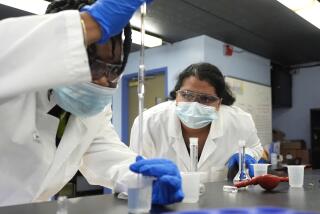Lead Poisoning: A Real or Hyped-Up Danger?
I take offense at the March 20 childhood lead-poisoning article (“Old Paint Young Victims” by Stephanie O’Neill). Occupying 80% of the page is an inflated article complete with a picture of mom and daughter, stricken by lead poisoning.
Your article is an example of good/bad reporting. Your mission is to educate your readers to the dangers of lead poisoning but it is done out of proportion to its danger, especially in California.
For example, your headline says “An estimated 3 million children in the U.S. suffer from lead contamination.” Yet later in your article you report 700 cases of childhood lead poisoning statewide in 1993, and only 12% of those cases were considered “medical emergencies.” That’s 84 out of a total statewide population of over 28 million people!
Using specific heartfelt cases of individuals suffering the contamination is common journalistic practice, but it can also result in a prejudiced communication.
It wasn’t until I read the smaller companion article (“Should You Test Your Child?”) that a reality check was done. Three doctors point out resources are better spent elsewhere than by testing for elevated blood levels.
It would have been more responsible journalism to incorporate these doctors’ observations within the lead article in the interest of balance.
PHYLLIS MUELLER
Pasadena
*
In her article, O’Neill writes “. . . there are no government loan programs or other financial assistance aimed specifically at private lead abatement work.”
True for now. However, there is a campaign sponsored by the Alliance to End Childhood Lead Poisoning and the Environmental Defense Fund to push House Resolution 2479, which would impose a “polluter pays” excise tax on the lead industry.
This legislation would provide an additional $1 billion dollars to local governments to help improve the health and well being of local communities, creating tens of thousands of high-skilled jobs without raiding other federal programs, or raising the deficit.
JOHN J. CURRAN
El Segundo
*
I would like to thank The Times for addressing such an important issue as childhood lead poisoning caused by lead-based paint.
This is a disease that affects one in six children, resulting in slower cognitive development, lower IQ scores, deafness and in some cases mental retardation.
Lead poisoning is considered to be the No. 1 environmental health hazard to children, while at the same time, it is the most preventable. Yet, and this is extremely disturbing, there is no existing government financial aid targeted at lead abatement programs.
Our children are our future, and the moral obligation to deal with problems affecting children rests with us.
Please call 1-800-LEAD-FYI to learn more about childhood lead poisoning.
DIANE LYNCH
Los Angeles
More to Read
Sign up for Essential California
The most important California stories and recommendations in your inbox every morning.
You may occasionally receive promotional content from the Los Angeles Times.










